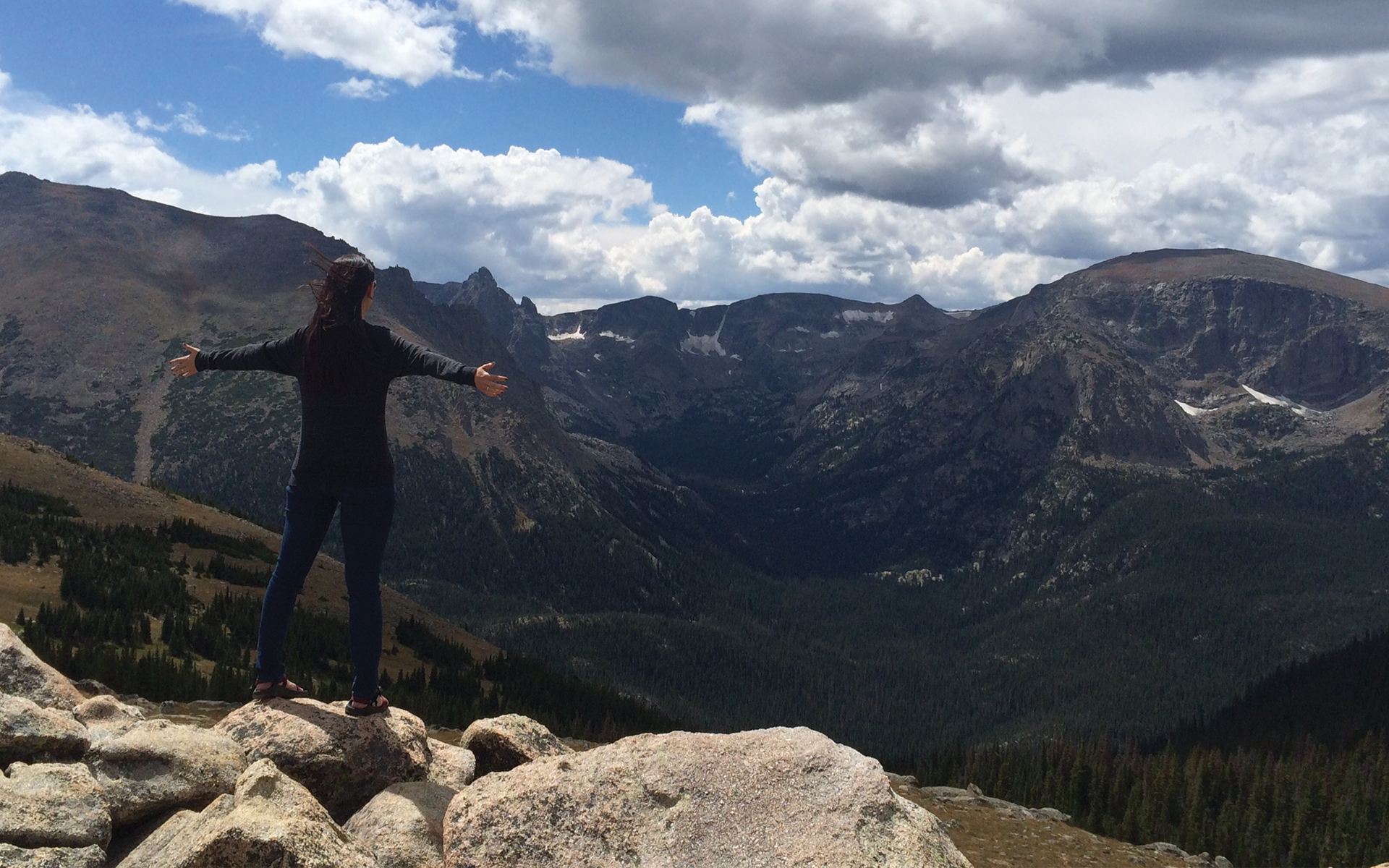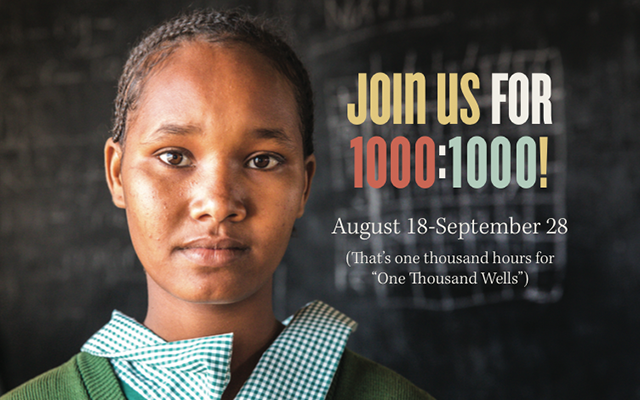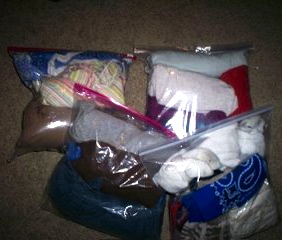Thursday night, I put on makeup and a fancy dress and walked into a ballroom with 450 co-laborers in the fight against HIV/AIDS to celebrate Blood:Water’s annual Red Tie Gala — a night dedicated to advancing the fight to end the HIV/AIDS crisis in Africa. I went into the night with a heavy heart but left with deep gladness. You see, a year ago I lost a dear friend named Joseph to a secret he had kept hidden from everyone close to him.
Mountaintop Lessons
Africa is my home away from home. But so are the mountains. The crisp, fresh, quiet air relaxes me to my core. I breathe in and all the stress and worries of the day exhale with me. When I stand on a mountaintop I am reminded of two important lessons I had to learn somewhere along the way — 1. to take on immoveable mountains, the first thing you have to do is move; 2. it’s important to take moments of true rest.
I didn’t used to love the mountains. In fact, all mountaintops were my Everest — never seemingly within reach, a feat I’d never conquer. Back in junior high I went away to summer camp and settled into activities well within my comfort zone. I prefered the repetitive nature of the same activity day in and day out over trying anything new. But one day, my counselor put the kibosh, if you will, on my activity of choice and informed me I would be participating in an overnight hiking trip up a mountain.
If you read my memoir, “One Thousand Wells,” I go into more detail of this story. But to sum it up, the beginning of the trip was terrible. I was weak; I was not happy; I wanted nothing to do with the mountain. But fellow campers wouldn’t let me give up; they pushed me, and together we reached the summit.
I learned a lot that day — community, risk taking, reaching goals together. But most importantly, I learned that to take on immoveable mountains, the first thing you have to do is move. You have to grow used to the weight of your pack, adjust your lungs to the quality of the air, and build muscle for the grade of the incline.
We live in a world with an attention span climate that changes so fast many of us are too scared or too distracted to move in any one direction in particular. So we turn around in circles, never really moving. We must put down the comforts that are actually chains encircling us and step out of the repetitive activities we’ve cemented around our feet. We can climb our Everests together, but we must move.
I said at the beginning of this post that when I stand on top of mountains I am reminded of two lessons. The second may seem like an oxymoron to the first — it’s important to take moments of true rest.
Once we start moving or climbing, sometimes our momentum carries us so fast the world begins to rush on by. Priorities get whipped into the frenzy of deadlines and good intentions, that pieces of life begin to suffer. We can grind so hard at the mountain ahead of us, that we grow faint along the way and never make it to the top.
Just like moving is the key to taking on immovable mountains, so is resting.

This photo of me on a mountain was taken just yesterday. It’s in Estes Park, Colorado. I am currently on a 22-day journey across the country showcasing my new book. I’ve met amazing people along the way, and I’ve loved telling my story.
But plane ride, after car ride, after late nights, after early mornings begins to wear on anyone. Don’t get me wrong; I’m not complaining. But that mountain couldn’t have come at a better time. It was brief, but it was exactly the rest I needed to continue climbing.
Surprise from Blood:Water
I love my Blood:Water family. Not only are they championing my memoir, "One Thousand Wells," they launched a surprise campaign in honor of the book.

Starting August 18 — the week before my memoir released — they launched 1000:1000. They are spending one-thousand hours for "One Thousand Wells" to bring 800 kids in Africa access to clean water.
They are raising funds to build raintanks at two different schools in Kenya. You see, kids in Africa often are forced to miss class or school altogether because they are out collecting water to drink. By providing clean water at school, kids are back in the classroom learning, ultimately helping create a brighter future.
Would you like to join Blood:Water's 1000:1000 campaign? Click here.
Why Should I Chase After a Lost Cause?
When I was in high school, my classmates voted me “Most likely to devote my life to a lost cause.” A decade and a half later, some may still give me that award.
Cofounding an organization to take on the HIV/AIDS and water crises in the world’s second largest continent, probably looks like a lost cause to many, if not most. But as I peer over the African desert and into the rest of the world, skipping from news headline to news headline, I, too, feel the weight of what looks like lost causes, where problems seem bigger than the time, resources, and attention spans we have to tackle them. Taking a sweeping glance around the room, we are so buried in smartphones, text messages, and our own immediate circumstances, I can’t help but think, “Who will answer these lost causes?”
But we need not fear.
Continue reading the rest of this blog on WAY-FM.
With thanks to the Giffords
A couple of years ago, Jars of Clay and I found ourselves on our way to Key Largo, Florida, where Frank and Kathie Lee Gifford had offered to host a fundraiser for Blood:Water in their Ocean Reef home. The exclusive gated community towered along the edge of the kind of beaches that I had only seen in magazines. We commuted by golf carts, dined with millionaires, and had access to the most perfect coastal air. The Gifford’s home was stunning, their friends were so kind and welcoming, and yet I couldn’t feel further from where I had just been.

One week earlier, I was tucked beneath the mosquito net of my bed in a Kenyan village, listening to the bloodcurdling screams of a child in pain. Our clinic was just a few hundred feet from us, and you don’t have to listen too closely to know what helplessness sounds like. A two-year-old boy in desperate need of an IV had severe dehydration. It was nearly impossible to find intravenous access on his body. Baby Alfred wailed as multiple attempts were made on his tiny little hands. Eventually, the clinicians succeeded and breathed a sigh of relief, and they moved on to the next patient. Our over-worked and exhausted clinicians served through the night as the hours eked by. Every bed was full. Patients continued to come through the night, whether on the back of a motorcycle as it hastily passed along the dirt path to the hospital doors or on one of the multiple runs of the hospital ambulance.
On most days, the noises in the village are the songs of small triumphs, murmurs of hope through the daily work of transforming this community toward health and healing. But that night, staring into the darkness, through the sounds of rushing vehicles, crying babies and colleagues shuffling through the dorm to grab juice and bread for the overwhelmed nurses, I could only hear the deep, dark voices in my heart that spoke about defeat and injustice and inadequacy. Nine babies died while I was there that month, and then I returned home to a different world.
If you think too hard about how wide the gap for the richest of the rich and the poorest of the poor actually is, it can make you a very cynical person. It can feel discouraging, disgusting even. But there in the hospitality of the Gifford’s family room, Kathie Lee interviewed me in front of her friends and asked me to share about the people I knew in Africa. I thought of baby Alfred and the overworked nurses and the occupied beds. And I leaned into my calling of knowing and loving people from opposite sides of the world, and introducing them to one another. And then, in a way that only she could do, Kathie Lee made a powerful and beautiful invitation to her community to give generously to our friends in Africa. And they did, almost as much as any group of people had for Blood:Water before.
No one is disqualified from responding to the love of mankind, and that’s the beautiful thing about love — it binds us to one another, regardless of what station in life we are in. In light of the recent passing of Frank Gifford, I give thanks for his life and for the spirit of generosity and love that both he and his lovely wife embody. I pray for his family as they grieve his passing, and I hope to God they know how deeply their generosity, advocacy, and faith affect these least of these.
Love Stories in One Thousand Wells: Video Blog 2
Today I am launching part two in the video blog series on my memoir, "One Thousand Wells." This week's juicy question: Are there any love stories in the book. Watch the video blog to find out the answer to that and many other questions. "One Thousand Wells" releases August 25. You can pre-order it at onethousandwells.com.
https://vimeo.com/135214735
The Art of Packing for Africa
photo 2
I like to think of myself as a seasoned traveler. Since the beginning of Blood:Water over 11 years ago, I have traveled to Africa more times than I can count. I have mastered the art of fitting two week’s worth of clothing into a carry-on bag… yes carry-on. I would highly recommend traveling with only carry-on luggage. This will practically erase the possibility lost luggage and will make traveling while in Africa infinitely easier. I do confess now that I travel with an under 2-year-old son, my masterful packing days have gone slightly by the wayside. Just read this blog post for proof. Perhaps this will inspire me to write a post on how to pack a carry-on only while traveling with a baby. We will see.
IMG_3263
I digress. So without further ado, here are my top five tips for packing:
1. Clothes to Pack
p1shirts
- 5-6 short-sleeved t-shirts (Ladies, remember to keep it classy and modest! Gentlemen, button up shirts with a collar are preferred)
- 2 long-sleeved t-shirts
- 1 t-shirt and 1 pair of shorts/boxers for sleeping
- 1 pair of jeans for days in transit or in a city
p3skirts
- For Women: 3-4 lightweight knee or ankle-length skirts (most women wear skirts, but be sure that your knees are always covered, as anything higher is considered immodest in rural Africa) plus 2 pairs of lightweight pants or capris (comfortable for the long plane ride )
- For Men: 3-4 light-weight khakis (WITHOUT zip off shorts or cargo pockets) or semi-dress trousers with a belt (most men dress formally even in rural settings)
100_0487
- 1 fleece or zip-up outer layer
- 1 lightweight rain jacket
- 2 bandanas
- 10 pairs of underwear
- For Women: 3-4 pairs of socks
- For Men: 7-8 pairs of socks
p5plane
- 1 pair of comfortable walking shoes
- 1 pair of semi-dress shoes (flats for ladies, loafers for men)
- 1 pair of sandals or flip-flops
- Sunglasses and/or hat
2. Gear and Documents to Pack
p6gear1
- Quick-dry towel (you can find this at any camping store like REI or LL Bean)
- Headlamp with extra batteries
- Nalgene (or other) water bottle
- Alarm clock (or watch with an alarm)
- Smart phone for music (remember that you likely will not use your cell phone for calls)
- Earplugs
- Camera
- Universal electricity plug adaptor (REI carries an all-in-one adaptor that I prefer)
- Granola bars or Power Bars (or any other small snack that is familiar and comfortable for you)
- Passport and Driver’s License
- Additional copy of passport and driver’s license, kept separately from your originals
- Travel Insurance card (or make sure the person/group you are traveling with has it for you – Blood:Water provides insurance cards to everyone who travels with us)
- Notebook and pens
- Book (or eReader, which is a fabulous way to travel with multiple books)
- ATM card (remember to call your bank before you leave so they know you are traveling internationally and won’t hold withdrawals placed out of the U.S.)
- U.S. cash (make sure that any $50 and $100 bills are dated AT LEAST 2009 – anything printed before 2009 may not be accepted
- Inoculations proof (you will receive a yellow card – just keep it in your passport)

3. Toiletries to Pack
p7gear2
- 2-3 packs of travel-size baby wipes
- Toothbrush, toothbrush cover, and travel-size toothpaste
- Floss
- Hairbrush/comb
- 3 packs of travel-size Kleenex
- Mini travel mirror
- 2 razors and travel-size shaving cream
- 2 travel-size packs of hand sanitizer
- Contact solution and eyeglasses (if applicable)
- Sunscreen – at least 30 SPF
- Insect repellant
- Deodorant
- Travel-size hand or body lotion
- Travel-size shampoo and conditioner
- 1 small roll of toilet paper (you can roll your own or get Charmin’s travel-size version)
- 3-4 travel-packets of dry laundry detergent (Tide or Shout both work great)

4. Medicine and First Aid to Pack
p13meds3
- Malarone – Malaria pills (remember to take one every morning with food)
- Sleep aid (I generally take one on my first two nights in Africa to help me settle into the new sleep schedule)
- 1 small bottle of Pepto-Bismol pills – stomach aid (I generally take one every morning to coat my stomach)
- 2 rolls of travel-size Tums – antacid
- 1 broad-spectrum antibiotic (I use Cipro – you will need a prescription for this)
- Small bag (10-15) of cough drops and/or throat lozenges
- Travel-size tube of Cortizone – anti-itch cream
- 3-4 packets of Emergen-C (or other)
- Various size band-aids – 2-3 of each size
- Neosporin

5. Packing — The Main Event
p17total4
I know it may sound crazy, but, I promise – you CAN fit all of the above into one small/medium-size rolling duffle bag or suitcase (make sure to confirm that it matches size regulations for carry-on luggage!), one backpack, and one purse or messenger bag that you can carry with you every day in Africa. Here are some helpful tips on how to do that (hint: it all comes down to plastic bags!):
p15total2
- Gallon-size Ziplock Bags: roll up all your clothes and seal them in Ziplock bags, squeezing out all the air to create a vacuum-like pack.
- Carry-on Liquids: Remember that (A) All carry-on liquids need to be less than 3oz and (B) they need to fit into a quart-size bag.
p11meds1
- Medicine: In order to save space, I put my medicines in little pill bags that you can buy at drugstores like Walgreens. If you do this, remember to make sure each bag is labeled so you don’t mix up your medicines! I like to take the label or sticker off the original packaging and include it right in the bag with the medicine. Once all your little bags of medicine are ready, just put them into one of your ziplock bags!
And there you have it! If you’d like to travel with Blood:Water to Africa, visit bloodwater.org/visiontrips.


















